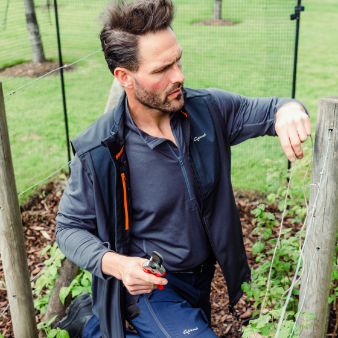Q&A with Martin Duncan, Head Gardener, Arundel Castle

Tell us about your journey into horticulture/transferable skills.
I was brought up in Zimbabwe and spent a lot of my childhood outside. My parents loved gardening and had a wonderful collection of orchids. This passion passed down to me and I went on to study commercial horticulture followed by advanced landscape design and construction in Wales.
I’ve had a wide range of positions including Head Gardener at Audley End, English Heritage and Senior Superintendent for the Botanical Gardens, Parks and Arboretum in Bermuda before moving to Arundel Castle where I've been for almost 14 years.
What attracted you to Arundel Castle and your role there?
Instantly, I was attracted to the stunning views of the Castle, Cathedral architecture and surrounding landscape. Knowing that the Duke and Duchess of Norfolk wanted to take the gardens forward I realised this was a great opportunity to enhance the existing gardens and create new gardens to be proud of. I love the design element of my work and it is enormously rewarding to see my vision brought to life with my team of gardeners.
Tell us about areas of the gardens you are most proud of
Introducing the Tulip Festival was a great highlight and to date boasts over 1.2 million bulbs which include narcissus, tulips, Camassia, alliums and Snakes Head fritillaries, weaving through the gardens and landscape and offers a feast for the eyes. The rose garden was one of the first areas I enhanced by adding gothic rose archways and seats to echo the castle's gothic windows that tower above this area. But, designing and implementing the botanical Stumpery Garden in 2013 is the area I’m most proud of. It’s a quirky and unique space made with wonderful ancient stumps, from trees such as Yew, Sweet Chestnut and Oak which fell in the 1987 storm. They have been positioned with their roots upwards, and surrounded by carefully orchestrated plantings throughout the year.
Do you have any favourite planting combinations and recommendations?
Growing tulips in pots is a great way of combining bright colours you wouldn’t normally think of such as T. Mont Orange with T. Purple Prince, or for a really pretty look Angelique Tulip inter planted with blue Forget-me-Nots. I also love our blue and white Camassia in the long grass, along with our white Thalia Narcissus. We’ve been reducing mowing and our carbon footprint whilst attracting pollinators by turning much of the landscape into perennial wildflower meadows and I’d recommend wildflowers for any garden size. You can buy wildflower turf, seed or compost infused with a variety of wildflower seed. Yellow rattle is excellent at reducing the amount of grass allowing the flowers to thrive – best sown in November when there’s a frost! Annual wildflower seed mixes are a great idea – sow the seed in April/May with kiln dried sand to give an even spread. One of my biggest gardening tips is to ensure that your soil is suitable and well prepared to suit your planting. I am a great believer in minimum tillage - here we just add a good top dressing of well rotten compost every year to our beds.
What are your future plans?
My latest project has been creating a ‘Dipping Pond’ which will be for education groups to learn about the biodiversity and ecology of our natural spring fed ponds, which we hope will be ready for opening in July this year. During November and December last year over 10,000 tulips were planted up the steep banks of the Castle and will be an incredibly dramatic show with the magnificent Castle as a backdrop, whilst in the Collector Earls gardens’ labyrinth 14,000 Kings Blood tulips have been planted.







